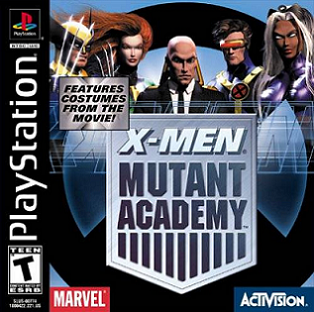
X-Men: Mutant Academy and X-Men: Mutant Academy 2 are a duology of early 2000s Fighting Games for the Playstation starring the eponymous mutants of Marvel Comics fame. The games are played on a 2-D plane, but with 3-D rendered models and backgrounds, very similar to contemporary franchise Street Fighter EX.
Neither game has anything much in regards to story, even by the standards of the genre. The manuals for both games suggest that they are nothing more than training scenarios for the X-Men to get full control of their powers, though the arcade mode of the first game does contain (unlockable) boss characters in the form of Magneto and the Brotherhood of Evil Mutants. The second game goes even further in the "no plot" thing by not even having a designated boss character, just giving everyone a rival character to beat the game with (ex: Cyclops fights Havok as his Arcade boss).
There are a few key difference between the two games; first is the roster — the first game features ten playable characters, including the unlockable bosses, and the second game upgrades to eighteen (again including unlockables). Second is the inclusion of aerial combat mechanics; similar to the Marvel vs. Capcom games, you can launch opponents high into the air and combo them for big damage. There is also some streamlining to other existing mechanics to make them easier to use.
The games were followed up by X-Men: Next Dimension which takes the series into full 3-D fighting.
Mutant Academy 1 Roster:Note: Bold denotes unlockable characters.
- Cyclops
- Wolverine
- Storm
- Beast
- Gambit
- Phoenix
- Toad
- Sabretooth
- Mystique
- Magneto
Mutant Academy 2 Roster:Note: Bold denotes unlockable characters.
All of the above, no unlocking required, as well as:
- Rogue
- Forge
- Havok
- Nightcrawler
- Psylocke
- Juggernaut
- Professor X
- Spider-Man
X-Men: Mutant Academy and it sequel feature the following tropes:
- And Your Reward Is Clothes: You can unlock multiple character costumes, including a Beach Party theme and ones based on the film.
- A Winner Is You: Spider-Man's ending in the second game is simply an advert for Spider-Man 2 – Enter: Electro.
- Beach Episode: Both games feature a mode where you play as the characters in beachwear, their weapons replaced by beach toys.
- Beam Spam: Cyclops and Havok, naturally.
- Big Bad: Magneto in the first game. He's the final boss if nothing else. Completely subverted in the second game, where there everyone fights a rival rather than a designated boss character.
- Death Dealer: Gambit, by way of his trademark Kinetically charged playing cards.
- Flying Brick: Rogue is depicted in her powers-stolen-from-Miss-Marvel form; just as that was beginning to be phased out as her status quo.
- Gadgeteer Genius: Forge, whose power is pretty much literally this. He uses a variety of gadgets and weapons for his Special Moves.
- Guest Fighter: Spider-Man, a secret character in the second game. True, he's a fellow Marvel Comics character with some ties to specific members of the group, but he's still not considered an X-Men character.
- Healing Factor: Wolverine's main power, and his level 3 Super Move. Portrayed as basically a cure spell.
- Joke Character: While Secret Character Professor X can use his telepathic abilities, his combat skills are limited to kicking his enemy in a wheelchair, and a single weak punch. He also can't jump for obvious reasons.
- Limit Break: Each character has 3 Super Moves of progressing power levels, naturally with level 3's being the most powerful. The actual resource management is somewhat unique, though. Each super move only uses the bar its associated with, and there are mechanics in place to move the Super Meter energy from one level to another.
- Mini-Game: Level 2 supers all come with a quick Simon Says style mini game, which when played successfully boosts the power of the move.
- Mission-Pack Sequel: Even when compared to other fighting game sequels at the time, Mutant Academy 2 is basically Mutant Academy with more stuff.
- No Plot? No Problem!: Neither game has any real story, not even an Excuse Plot.
- Power Copying: Rogue can drain her opponent's powers. Usually in the form of a special move she can use, but copying Gambit gives her a temporary stat-up.
- Sequel Escalation: Mutant Academy 2 almost doubles the character list from its predecessor.
- Shock and Awe: Storm's powers manifest almost exclusively via electric attacks.
- Shotoclone: In theory, Cyclops is the Ryu of the game, an all rounder usable at all ranges. The second game gives us his brother Havok, who largely becomes his Ken.
- Status Effects: Phoenix's level 1 Super move confuses the opponent, screwing with their controls.
- Teleport Spam: Nightcrawler's fighting style in a nutshell.
- Trap Master: Gambit and Forge can both lay timed mines to help keep opponents away — charged cards for Gambit and actual mines for Forge.
- Wolverine Publicity: Logan himself is present, naturally, and is prominently featured on the cover art to both games.
